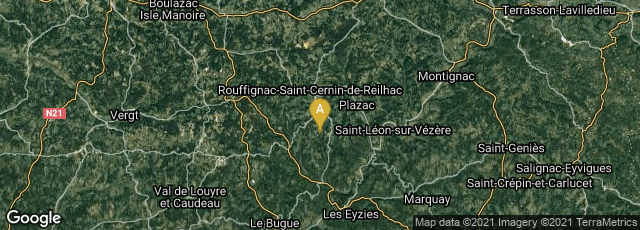

A: Rouffignac-Saint-Cernin-de-Reilhac, Nouvelle-Aquitaine, France
In 2006 Kevin Sharpe and Leslie van Gelder published "Evidence for Cave Marking by Paleolithic Children," Antiquity (2006) 80:310, 937-947. In this paper they presented evidence that the numerous finger flutings in Chamber A1 of Rouffignac Cave within the French commune of Rouffignac-Saint-Cernin-de-Reilhac in the Dordogne département were made by very young children, 2-5 years old.
"A wall in Gargas Cave, France, shows a baby’s hand held by that of an adult while color is blown over them. Footprints of youngsters have been immortalized into the floors of Pech Merle, Chauvet, Tuc d’Audoubert, and Niaux caves. All these sites also contain prehistoric art. Children were present in the caves, but did they actually produce art or at least deliberately create any of the markings (the corpus of which is called ‘art’ within quotation marks, to recognize the unanswered question as to whether it should count as art)? Whatever the minor impressions of Paleolithic children in caves, this image is often forgotten in favour of the popular image from the Charles R. Knight type of picture that shows the proverbial cave man painting beautiful images of animals – with women and children only looking on.
"Some specialists of prehistoric parietal ‘art’ believe that children did participate in its creation. Bednarik argues that juveniles were responsible for some of the finger flutings (the lines that human fingers leave when drawn over a soft surface) made in caves in southern Australia at least 30,000 years ago (Bednarik 1986a; 1986b; 1987-88; 1990). (Paleolithic flutings occur in caves through southern Australia, New Guinea, and southwestern Europe.) As will be pointed out below, however, the case Bednarik makes is more suggestive than definitive, relying on a methodology that requires further refinement with forensics.
"This report introduces a reliable methodology with which to ascertain children’s authorship of flutings, and then provides the results of a study using this. Unlike Bednarik’s, and Sharpe and Van Gelder’s (2004) earlier publications on the subject, definitive evidence is presented that children did indeed create prehistoric ‘art,’ in particular that young children fluted in Rouffignac Cave in the Dordogne, France. This conclusion leads to further questions and insight into the activities carried on in the fluted chamber. . . .
"Conclusions
"Young children aged 2-5 made many of the flutings in the fluted subchamber of Chamber A1 in Rouffignac Cave. This is the first demonstrated case of young children creating Paleolithic parietal ‘art.’
"Given that this can be ascertained with a high degree of probability based on the physical evidence of the flutings, further matters present themselves for research and other informtion may be learned about the fluters. For instance, an aspect of Chamber A1 to notice is the height of the ceiling above the floor. The ceiling flutings are now in places just reachable by a man of 1.8 m. stretching up. It is unreasonable to think that young children marked unaided at such heights, yet the fluting size in some such places is small. Was the height of the ceiling above the floor at the time of fluting much the same as now? If so, or if the height were greater than now, the children would have had to have been held up to flute. In what direction did the children face when held aloft? Were the children acting as ‘paint brushes’ for those holding them up? Were the people holding up the children moving in some prescribed manner, such as in a dance? If so, could their feet and body movements be reconstructed from the flutings?
"Why did those holding up the children to flute do this? The youngsters could have fluted where they could reach and the holders (if older people) could have marked, not only these sections, but also sections where the youngsters could not reach. Here, however, they raised the children up to flute (and in some alcoves added their own flutings). Further, the low sections of the ceilings that young children could comfortably flute by themselves usually show few or no flutings. //While the archaeologist ought not to approach flutings with strident ideas as to what they mean, the flutings’ illusive meaning should not deter an examination of them. They can offer a rich source of information about the behaviors of the fluters – flutings tell about the fingers and hands that made them and these tell about the people – and the archaeologist ought to look in depth at the flutings as physical objects. Only then can questions be posed that the lines themselves might answer or that experimentation might elucidate. Such investigations logically come before subjective-interpretative and meaning-seeking approaches to flutings and may help support or disprove the various hypotheses as to their connotation or lay a solid foundation for seeking meaning.
"Similar methodologies are being applied to other flutings in Rouffignac and elsewhere, relating information not only about the ages of the fluters, but also about such data as the fluters’ genders and the number of individuals involved. At least three other forms of flutings besides the Mirian Form exist in Rouffignac (Sharpe and Van Gelder To Appear) and work continues on them in Rouffignac and Gargas caves, to see if it is possible to elucidate further the behaviors and individuals behind their manufacture" (http://www.ksharpe.com/word/AR86.htm, accessed 12-17-2011).